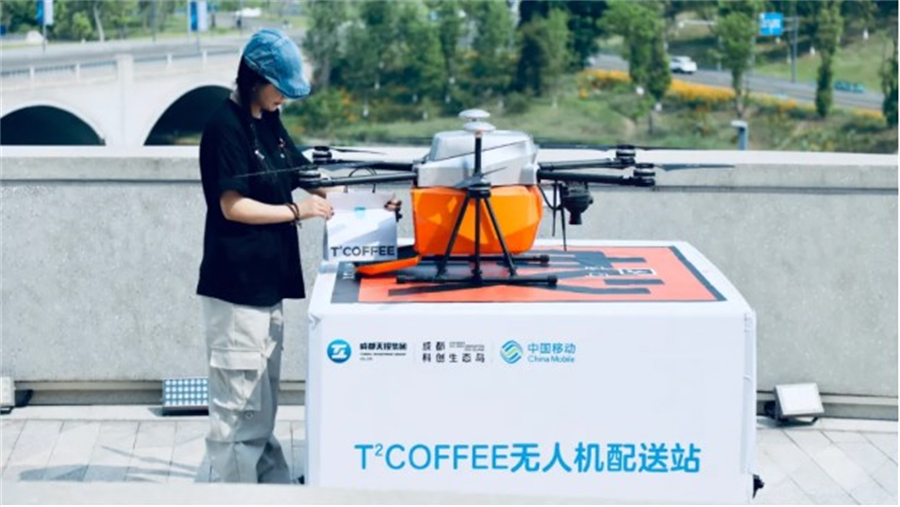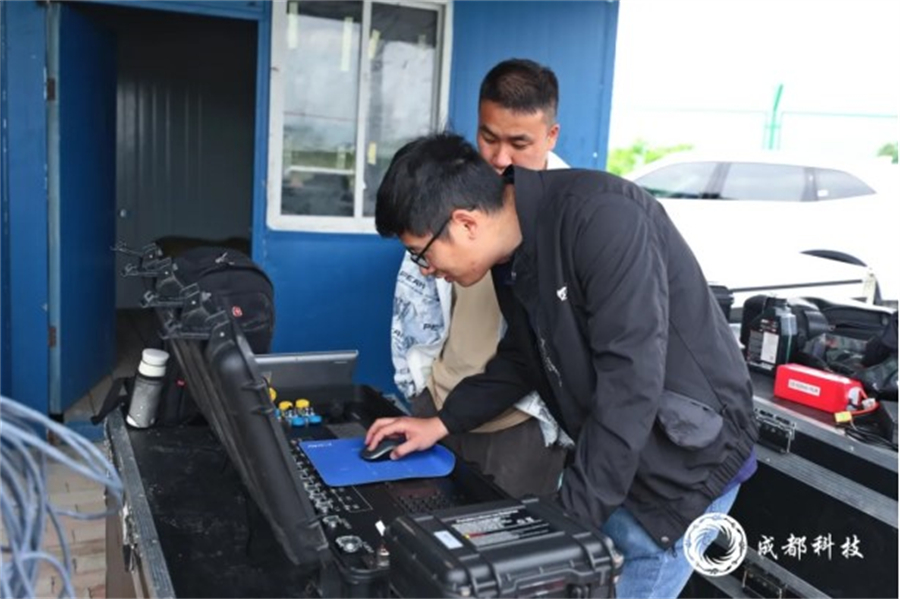Chengdu speeds up development of low-altitude economy
A tourist surnamed Yao visiting the Danjing Mountain in Pengzhou, Chengdu, southwest China's Sichuan province just experienced the convenience of drone delivery - soon after he stepped into the scenic area, a drone delivered to his hands a cup of hot coffee he had previously ordered on his phone.
Chengdu is among the first batch of pilot cities of China's low-altitude airspace management reform. Striving to build itself into a center of low-altitude economy in west China, the city is strengthening its exploration in development and manufacturing, low-altitude airspace development, scenario innovation, and integrated development.

A drone delivers coffee in Chengdu, southwest China's Sichuan province. [Photo provided by Tianfu New Area, Sichuan province]
This year, the city aims to improve the output of its low-altitude manufacturing sector to 6.5 billion yuan ($895.63 million) and expand the size of its low-altitude economy to 26 billion yuan.
"We handled over 500 food delivery orders during the Spring Festival, and we flew more than 100 flights per day when visitors came to enjoy the flower blossoms, which made us internet-famous. The popularity is totally beyond our imagination," said Zhou Xiaoming, chairman of a drone tech firm based in Chengdu, the operator of a national-level flight-testing center for unmanned aerial vehicles (UAVs) known as "Sky Eye."
According to him, currently the company runs six routes deep in the valleys along the Jianjiang River in Longmen Mountains, Sichuan province, which can not only deliver coffees, but also “paradrop” hotpot food and groceries based on users' demands.
It takes only about 20 minutes for the drones to deliver stuffs from merchants to scenic areas, B&B hotels and camp sites, Zhou added.
Apart from daily life scenarios, drones are also widely applied in industries such as emergency rescue and meteorological observation in Chengdu.
For example, the long-range and multipurpose Wing Loong drones have become a strong force in China's meteorological and emergency support systems, assisting artificial precipitation, monitoring meteorological phenomenon in the sky and ensuring stable cloud communication.
An executive of AVIC (Chengdu) UAS Co., Ltd. noted that the company will continue to innovate in low-altitude application scenarios and actively explore the new field of logistics transportation.
It is reported that Chengdu has now built a complete industrial chain covering raw materials, basic components and systems, complete drone manufacturing, and operational services.
It has gathered more than 110 upstream and downstream enterprises, with products ranging from 10 kilograms to tonnage level, covering 66 application scenarios such as urban governance and production operations.
Statistics show that in recent years, the industrial output of Chengdu's UAV industry has maintained an average annual growth of over 20 percent. Last year, the total revenue of Chengdu's UAV industrial exceeded 10 billion yuan, ranking among the top in China in terms of overall competitiveness.
Electric vertical take-off and landing (eVTOL) aircraft are also a focus of low-altitude economy. Nicknamed "flying cars," these aircraft are considered one of the most important carriers for the development of low-altitude economy.
As one of the first pilot cities of China's low-altitude airspace management reform, Chengdu has relaxed policies in the low-altitude sector, which has boosted the confidence of companies in launching their products.

Technicians debug drones at the "Sky Eye" flight test base for unmanned aerial vehicles in Chengdu, southwest China's Sichuan province. [Photo from the public account of the Chengdu municipal science and technology bureau on WeChat]
In July last year, AEROFUGIA, a tech firm in low altitude transportation and smart industry solutions owned by Chinese car manufacturer Geely, signed an agreement with Sino Jet, the largest business jet operator in Asia-Pacific, for the acquisition of 100 Chinese-made eVTOL aircraft.
The two will work together to promote the application of eVTOL in business aviation. Once the airworthiness certification is completed, Chengdu is expected to be the first city to apply eVTOL in business air travel.
Orderly and compliant opening of the low-altitude airspace is a prerequisite for low-altitude economy to "take off."
Every day, industrial drone enterprises would carry out various scientific and research tasks such as signal transmission and river channel inspection in the airspace of the "Sky Eye" UAV flight test base, which is below an altitude of 1,200 meters and covers a radius of 5 kilometers.
Zheng Wenqiang, director of a flight base of JOUAV, a Chengdu-based drone company, told People's Daily that over the past five years, he and his team have completed nearly 10,000 test flights of drones in the base.
"Stable time and range, as well as unique terrain and landforms, are necessary conditions for conducting test flights of industrial-grade drones," Zheng said.
"Sky Eye" covers diverse landforms such as mountains, hills, forests, rivers, and lakes, which can simulate the working conditions of industrial drones in actual application scenarios to the greatest extent, he explained.
Zhou said, "In the national-level flight-testing center for UAVs, you just need to provide notification one hour before takeoff, which greatly improves flight efficiency and helps achieve maximum flight capability."
It is learned that Sichuan province has designated seven airspaces for coordinated management and eight low-altitude visual flight corridors. Nearly 1/3 of Chengdu's territory is within the scope of the Sichuan low-altitude reform pilot airspace, which is public and open for regular flights.
Up to now, Chengdu's UAVs have completed over 8 million flights, accumulating 600,000 hours of flight time. The efficiency of airspace resource utilization has been significantly improved in the city.
























